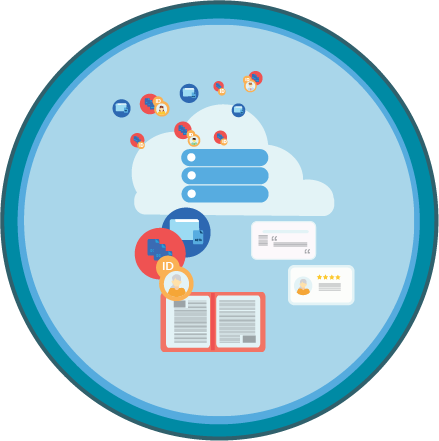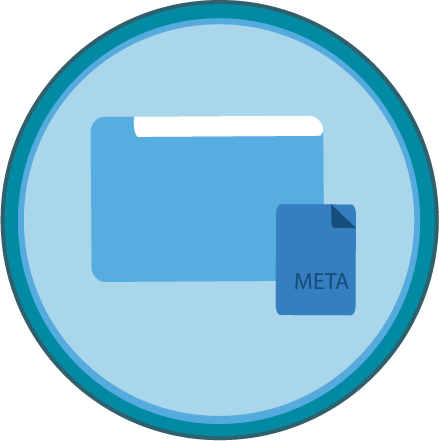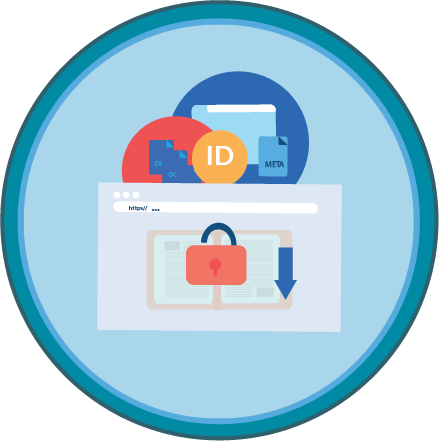What is FAIR?
The FAIR universe is populated by concepts and acronyms that you may not be familiar with. You will learn about all of them, as you make your way through this website. On this page, you can read about three fundamental concepts: the FAIR principles, FAIR data, and FAIRification practices.
We presuppose that you have some knowledge of research data management practices. If you are completely new to the field, we recommend that you start by taking our e-Learning course on research data management.

The FAIR principles
The FAIR principles, first published in 2016, contain guidelines for good data management practice that aim at making data FAIR: findable, accessible, interoperable, and reusable.
"Data" refers in this context to all kinds of digital objects that are produced in research: research data in the strictest sense, code, software, presentations, etc. However, for the sake of simplicity, we use "data" and not "digital research objects" on this website.
Each letter in FAIR refers to a list of principles with a total of 15 principles altogether. A recent paper on the FAIR principles introduces the useful distinction between the four foundational principles that aim at findability, accessibility, interoperability, and reusability and the 15 guiding principles that more explicitly and measurably describe how FAIRness of data can be achieved through technical implementation.
Although the FAIR principles originate from the life sciences, they can be applied within all research disciplines. Since their publication, the European Union, national funders, and universities have declared their support for and approval of the FAIR principles. This spans from defining policies for data handling to the creation of data management tools and infrastructures. Some FAIR projects and implementations stick closely to the original definitions, while others are inspired by the spirit of the FAIR principles.
In order to properly understand FAIR, you should keep four things in mind:
Don't recall the FAIR principles?
Check out the presentation of the FAIR principles by the GO FAIR initiative.

1) Both humans and machines are intended as digesters of data.
This will lead to the creation of an ecosystem that is fast to respond to change and automatically adapts to new findings or changes: the Internet of FAIR Data and Services. This is the reason for focusing on standards for data, identification mechanisms, data availability, etc.

2) The FAIR principles apply to both data and metadata.
Where metadata are descriptions of or records about data. This is why the term “(meta)data” is stated in the principles.

3) The principles are not necessarily about open data.
You can work in a FAIR manner with data that is not intended for public availability.
4) The FAIR principles are not rules or standards.
The FAIR principles must not be mistaken for rules or standards that you can use to evaluate tools, data, policies, etc. This would soon make the principles out-of-date and inapplicable across research disciplines. Adopting the FAIR principles will often be a gradual adaptation of work routines – but it could also be a huge leap, where you replace one type of infrastructure with another. It will be up to the different research areas and research communities to make the FAIR principles work in their respective contexts.
This text is adapted from the introduction of A FAIRy tale.
FAIRification practices
How you apply the FAIR principles, depends on your specific discipline and your way of doing research. But there are different activities you must consider within your research workflows, if you want to make your data FAIR. For instance: documenting your data, choosing appropriate file formats, adding metadata, giving access to the data, licensing the data or adding a persistent identifier. On this website, we call these activities FAIRification practices.
To learn more about the six FAIRification practices, have a look at our e-Learning module 2 on FAIR data.

Documentation
Documentation adds rich context to your data and makes the data easier to understand and reuse in the future.

File formats
File formats determine how data can be used. It is important to decide what file formats to use for data collection, data processing, data archiving, and long-term preservation. File formats are important to consider, when you want to combine datasets or make data readable by machines.

Metadata
Metadata are data about data. Research data need metadata to become findable, accessible, interoperable and reusable - by humans and machines.

Access to data
Access to data means that you determine who you make your data available for, how you provide access, and under which conditions.

Persistent identifiers
To make your data accessible and easy to find, you must provide your data and metadata with a persistent identifier (PID). A PID is a long-lasting reference to a digital resource and provides the information required to reliably identify, verify and locate your research data.

Data licences
A data licence is a legal arrangement between the data creator and the data user that specifies what users can do with the data. It is one of the most effective ways to communicate permissions to potential data users.
Research Data Management e-Learning course
Within the framework of the Danish National Forum for Data Management, the Danish Universities have developed the following video e-Learning course on the importance of good Research Data Management.
The course below is divided into three independent modules. Each module consists of a 20 min video recording (including animations and interviews) that can be taken at a students' own pace and can be complemented with face-to-face training. The target group for the course is PhD students, researchers and research support staff who would like an introduction to the general concepts and terms used in research data management. However, others are also welcome to take the course.
It is open to all.
Holmstrand, K.F., den Boer, S.P.A., Vlachos, E., Martínez-Lavanchy, P.M., Hansen, K.K. (Eds.) (2019). Research Data Management (e-Learning course). doi:10.11581/dtu:00000047




